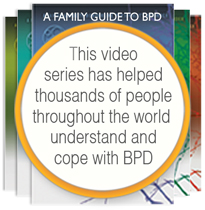Therapy
Dialectical Behavior Therapy (DBT). Dialectical Behavior Therapy is the most popular form of treatment for BPD. Developed by BPD expert Marsha Linehan, DBT consists of individual psychotherapy once a week and DBT skills training in a group setting. DBT skills are designed to help people manage their intense emotions. DBT may also involve the family and other supporters in the treatment process. It is recommended that the therapy and skills training be administered by a DBT certified therapist. Several studies have shown that DBT is effective in reducing suicide attempts and other self-harming behaviors as well as improving interpersonal relationships.
IF ONLY WE HAD KNOWN: A FAMILY GUIDE TO BPD
Mentalization-Based Therapy (MBT). Mentalization-Based Therapy was developed by Anthony Bateman and Peter Fonagy specifically for individuals with BPD. They describe mentalizing as the process by which a person is attuned to another person’s mental state – their thoughts, desires and feelings. BPD diminishes a person’s ability to mentalize and this lack of empathy can disrupt their ability to regulate their emotions and manage their impulses, impacting their social interactions with others. The overall goal of MBT is to enhance awareness and appreciation of the emotional states of other people in order to avoid those negative interactions.
Cognitive Behavioral Therapy (CBT). Cognitive Behavioral Therapy emphasizes problem solving and readjusting dysfunctional thinking. CBT is highly effective in the treatment of a variety of conditions including BPD. Many other BPD treatments are derived from CBT.
IF ONLY WE HAD KNOWN: A FAMILY GUIDE TO BPD
Transference Focused Psychotherapy (TFP). Another treatment specifically targeted for BPD is TFP which was developed by psychiatrists Otto Kernberg, John Clarkin and Frank Yeomans. Transference, a key concept in psychodynamic psychotherapy is the process in which emotions are transferred from the patient to the therapist. For example, the patient’s feelings about important people in his life (such as parents or caregivers) are transferred onto the therapist, so that the patient comes to feel about and react to the therapist as he would to these important figures. It is believed that through transference, the therapist can see how the individual interacts with people, and the therapist can use this information to help the individual build healthier relationships.
General Psychiatric Management (GPM). General Psychiatric Management is a comprehensive and highly structured approach to the treatment of BPD that is based on the American Psychiatric Association Practice Guidelines for the Treatment of Patients With Borderline Personality Disorder. GPM includes case management, symptom-targeted medication management for the treatment of the mood swings, impulsivity, and aggressiveness typical of BPD patients and psychodynamic psychotherapy. It is most effective when used by experienced psychiatrists and other therapists who have a genuine interest in the treatment of people who have borderline personality disorder.
Systems Training for Emotional Predictability and Problem Solving (STEPPS). STEPPS is a group treatment program for BPD developed at the University of Iowa by Nancee Blum and associates. In this cognitive-behavioral, skills-based approach, BPD is viewed as a disorder of emotional and behavioral regulation. The STEPPS program includes two phases – a 20-week basic skills group, and a one-year, twice monthly advanced group program called STAIRWAYS. The goal is to provide the person who has BPD, the professionals who may treat them, and close friends and family members with a common language to communicate clearly about the disorder and the skills used to manage it.
Schema-Focused Therapy (SFT) was developed by Jeffrey Young, to treat individuals with Borderline Personality Disorder, but can also be used with other people who had difficult childhood experiences. Schema Therapy is based on CBT principles, but is focused much more on early childhood traumatic events that have caused lifelong difficulties. Patients complete questionnaires to identify their negative life experiences (schemas) and coping styles, The therapist then helps the patient to develop the ability to change unhelpful thinking styles and patterns of behavior.
